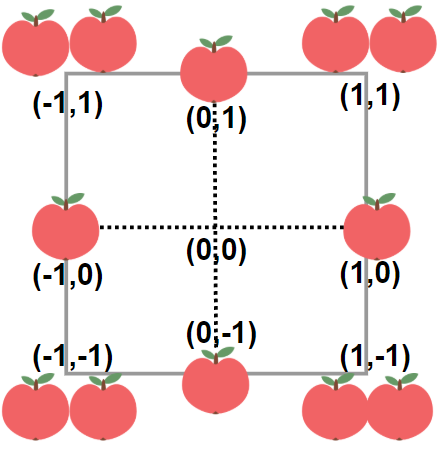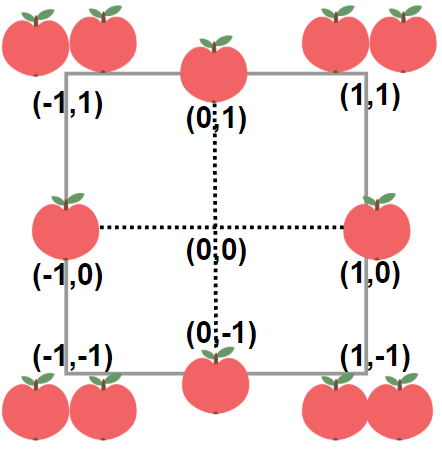原文链接: https://leetcode-cn.com/problems/minimum-garden-perimeter-to-collect-enough-apples
英文原文
In a garden represented as an infinite 2D grid, there is an apple tree planted at every integer coordinate. The apple tree planted at an integer coordinate (i, j) has |i| + |j| apples growing on it.
You will buy an axis-aligned square plot of land that is centered at (0, 0).
Given an integer neededApples, return the minimum perimeter of a plot such that at least neededApples apples are inside or on the perimeter of that plot.
The value of |x| is defined as:
xifx >= 0-xifx < 0
Example 1:

Input: neededApples = 1 Output: 8 Explanation: A square plot of side length 1 does not contain any apples. However, a square plot of side length 2 has 12 apples inside (as depicted in the image above). The perimeter is 2 * 4 = 8.
Example 2:
Input: neededApples = 13 Output: 16
Example 3:
Input: neededApples = 1000000000 Output: 5040
Constraints:
1 <= neededApples <= 1015
中文题目
给你一个用无限二维网格表示的花园,每一个 整数坐标处都有一棵苹果树。整数坐标 (i, j) 处的苹果树有 |i| + |j| 个苹果。
你将会买下正中心坐标是 (0, 0) 的一块 正方形土地 ,且每条边都与两条坐标轴之一平行。
给你一个整数 neededApples ,请你返回土地的 最小周长 ,使得 至少 有 neededApples 个苹果在土地 里面或者边缘上。
|x| 的值定义为:
- 如果
x >= 0,那么值为x - 如果
x < 0,那么值为-x
示例 1:

输入:neededApples = 1 输出:8 解释:边长长度为 1 的正方形不包含任何苹果。 但是边长为 2 的正方形包含 12 个苹果(如上图所示)。 周长为 2 * 4 = 8 。
示例 2:
输入:neededApples = 13 输出:16
示例 3:
输入:neededApples = 1000000000 输出:5040
提示:
1 <= neededApples <= 1015
通过代码
高赞题解
方法一:枚举
提示 $1$
如果正方形土地的右上角坐标为 $(n, n)$,即边长为 $2n$,周长为 $8n$,那么其中包含的苹果总数为:
$$
S_n = 2n(n+1)(2n+1)
$$
提示 $1$ 解释
对于坐标为 $(x, y)$ 的树,它有 $|x| + |y|$ 个苹果。因此,一块右上角坐标为 $(n, n)$ 的正方形土地包含的苹果总数为:
$$
S_n = \sum_{x=-n}^n \sum_{y=-n}^n |x| + |y|
$$
由于 $x$ 和 $y$ 是对称的,因此:
$$
\begin{aligned}
S_n &= 2 \sum_{x=-n}^n \sum_{y=-n}^n |x| \
&= 2 \sum_{x=-n}^n (2n+1) |x| \
&= 2(2n+1) \sum_{x=-n}^n |x| \
&= 2n(n+1)(2n+1)
\end{aligned}
$$
思路与算法
我们从小到大枚举 $n$,直到 $2n(n+1)(2n+1) \geq \textit{neededApples}$ 为止。
代码
[sol1-C++]class Solution { public: long long minimumPerimeter(long long neededApples) { long long n = 1; for(; 2 * n * (n + 1) * (2 * n + 1) < neededApples; ++n); return n * 8; } };
[sol1-Python3]class Solution: def minimumPerimeter(self, neededApples: int) -> int: n = 1 while 2 * n * (n + 1) * (2 * n + 1) < neededApples: n += 1 return n * 8
复杂度分析
时间复杂度:$O(m^{1/3})$,其中 $m$ 表示题目中的 $\textit{neededApples}$。可以发现,$S_n$ 是关于 $n$ 的三次函数,因此需要枚举的 $n$ 的数量级为 $O(m^{1/3})$。
空间复杂度:$O(1)$。
方法二:二分查找
思路与算法
由于 $S_n$ 是随着 $n$ 单调递增的,那么我们可以通过二分查找的方法,找出最小的满足 $S_n \geq \textit{neededApples}$ 的 $n$ 值即为答案。
细节
二分查找的下界可以直接置为 $1$,而上界 $\textit{right}$ 需要保证有 $S_\textit{right} \geq \textit{neededApples}$。根据方法一,我们只需要令 $\textit{right} = \lfloor \textit{neededApples}^{1/3} \rfloor$ 即可,其中 $\lfloor \cdot \rfloor$ 表示向下取整。但由于大部分语言中立方根运算较难实现,在实际的编码中,我们可以取一个更加宽松的上界,例如 $\textit{neededApples}^{1/3}$ 最大值 $10^{15}$ 的立方根 $10^5$。
代码
[sol2-C++]class Solution { public: long long minimumPerimeter(long long neededApples) { long long left = 1, right = 100000, ans = 0; while (left <= right) { long long mid = (left + right) / 2; if (2 * mid * (mid + 1) * (mid * 2 + 1) >= neededApples) { ans = mid; right = mid - 1; } else { left = mid + 1; } } return ans * 8; } };
[sol2-Python3]class Solution: def minimumPerimeter(self, neededApples: int) -> int: left, right, ans = 1, 100000, 0 while left <= right: mid = (left + right) // 2 if 2 * mid * (mid + 1) * (mid * 2 + 1) >= neededApples: ans = mid right = mid - 1 else: left = mid + 1 return ans * 8
复杂度分析
时间复杂度:$O(\log m)$,其中 $m$ 表示题目中的 $\textit{neededApples}$,即为二分查找需要的时间。
空间复杂度:$O(1)$。
统计信息
| 通过次数 | 提交次数 | AC比率 |
|---|---|---|
| 4334 | 9066 | 47.8% |
提交历史
| 提交时间 | 提交结果 | 执行时间 | 内存消耗 | 语言 |
|---|




